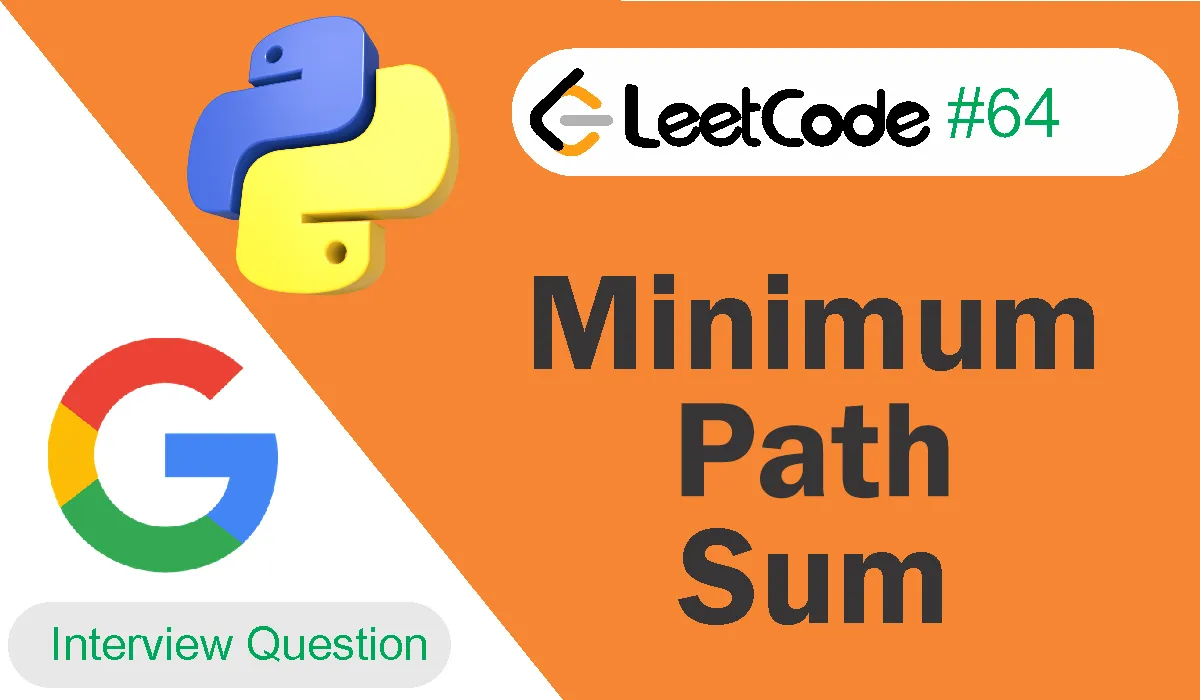Minimum Path Sum Leetcode Problem 64 [Python Solution]
Welcome to another coding adventure!
In this guide, we will tackle the LeetCode problem #64, Minimum Path Sum We'll explore how to find the path with the minimum sum in a grid filled with non-negative numbers, where you can only move either down or to the right.
We'll provide a Python solution to this problem and discuss its time and space complexity.
So, let's dive into the details!
Problem Overview
The problem presents us with an m x n grid filled with non-negative numbers.
Our goal is to find a path from the top left corner to the bottom right corner of the grid, minimizing the sum of all the numbers along the chosen path.
The catch is that you can only move either down or to the right at any given point.
Example 1:
Input: grid = [[1, 3, 1], [1, 5, 1], [4, 2, 1]]
Output: 7
Explanation: The path 1 → 3 → 1 → 1 → 1 minimizes the sum.
Example 2:
Input: grid = [[1, 2, 3], [4, 5, 6]]
Output: 12
Understanding the Constraints
Before we dive into the solution, it's crucial to understand the problem constraints:
- The dimensions of the grid are represented as m and n.
- The grid has non-negative values, meaning grid[i][j] >= 0.
- You can only move either down or to the right.
Now, let's explore the approaches to solve this problem efficiently.
LeetCode Problem Solution
1. Bruteforce Approach
One way to solve this problem is through a brute-force approach, where you explore all possible paths from the top-left to the bottom-right corner and calculate their sums.
However, this approach is highly inefficient, and for larger grids, it's impractical due to the exponential number of paths to consider.
2. An Efficient Approach with Dynamic Programming
The most efficient way to solve this problem is by utilizing dynamic programming.
This approach allows us to break the problem into smaller subproblems and efficiently calculate the minimum path sum.
Here's a Python solution for this problem:
def minPathSum(grid):
m, n = len(grid), len(grid[0])
prev = [float("inf")] * n
prev[-1] = 0
for row in range(m - 1, -1, -1):
dp = [float("inf")] * n
for col in range(n - 1, -1, -1):
if col < n - 1:
dp[col] = min(dp[col], dp[col + 1])
dp[col] = min(dp[col], prev[col]) + grid[row][col]
prev = dp
return prev[0]
This efficient approach uses dynamic programming to compute the minimum path sum.
It iterates through the grid from bottom to top and right to left, updating the minimum path sum for each position.
This allows us to avoid recomputing subproblems and ensures an optimal solution.
Time and Space Complexity
Now, let's analyze the time and space complexity of our efficient solution:
- Time Complexity: The time complexity is
O(m * n), where m is the number of rows and n is the number of columns in the grid.
We iterate through the entire grid once to calculate the minimum path sum efficiently.
- Space Complexity: The space complexity is
O(n), as we use an array to store the minimum path sum for each column.
We only need to keep track of one row at a time, which is a space-saving optimization.
Reasoning Behind Our Approach
The key insight in this problem is to recognize that each position's minimum path sum depends on the values below and to the right.
By working from the bottom-right corner to the top-left, we compute these values efficiently and avoid redundant calculations.
The dynamic programming approach allows us to break down the problem into smaller subproblems and use previously computed results to find the solution.
This significantly improves the efficiency of the solution.
Related Interview Questions By Company:
Related Interview Questions By Difficulty:
Related Interview Questions By Category:
- Insert Into A Binary Search Tree LeetCode
- Find The Index Of The First Occurrence In A String LeetCode
- Best Time To Buy And Sell Stock With Cooldown LeetCode
Conclusion
In this guide, we've tackled the LeetCode problem #64, "Minimum Path Sum," using an efficient dynamic programming approach.
We've provided a Python solution and discussed its time and space complexity.
If you found this guide helpful, please like and engage to support our our platform and stay updated on more coding adventures.
Feel free to comment, ask questions, make suggestions, and share this content to help fellow learners.
Happy coding!

